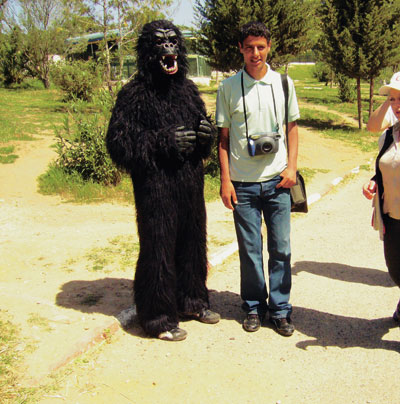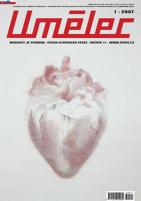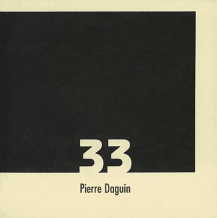| Umělec magazine 2007/1 >> Transculture: Act 1 a Project of Jesper Alvaer and Isabela Grosseova | List of all editions. | ||||||||||||
|
|||||||||||||
Transculture: Act 1 a Project of Jesper Alvaer and Isabela GrosseovaUmělec magazine 2007/101.01.2007 Tomáš Vaněk | en cs de |
|||||||||||||
|
The art exhibition in Brno called the Transculture Project: Act 1 of Jesper Alvaer and Isabela Grosse, represents part the Polish concept of “transculturation,” and is part of a larger series of exhibitions with the same name, Transculture, organized by the Bunkier Sztuki art gallery in Krakow, Poland. Each of the six exhibitions making up Transculture is composed of different artists representing their experiences with the topic of emigration. These artists— Pavel Braila, Olaf Breuning, Adrian Paci, Shahram Entekhabi, and Loulou Cherinet—are being shown from 2006 until the end of 2007 in exhibitions accompanied by workshops and panel discussions with professionals from the fields of cultural anthropology, sociology and European studies. The project will conclude with an international conference co-organized by the European Culture department of the Jagiellonian University, Krakow. The conference, in which the concept of Transculture will be discussed by Professor Zygmunt Bauman, professor Władysław Bartoszewski and Ryszard Kapuściński, will feature the place of its origin—Poland. The goal of the conference is to highlight connections that underlie the concept of Transculture and their transformations in the countries of Eastern and Western Europe.
The Journey on the Border Jesper Alvaer and Isabela Grosse traveled to the northernmost parts of Africa during the first half of 2006. visiting Morocco, Algeria, Tunisia, Libya, and Egypt. They based this sojourn on a goal they had defined a long time prior: to visit all the countries politically and geographically neighboring Europe. More accurately, the states creating its most discussed periphery. They went to Africa as tramps. Zygmunt Bauman, in his book "Globalization: The Human Consequences,"(1) defines the tramp as the alter ego of the tourist. He writes that both the tourist and the tramp are consumers and that late modern, or postmodern, consumers are the searchers and collectors of experiences. Their relationship with the world is firstly aesthetic: they welcome the world as nourishment for their sensitivity – and the world offers a matrix of possible experiences. Bauman then compares both tramps and tourists, in their savoring of the world, to museum visitors who relish in having personal contact with works of art. Bauman’s general definition has a distinct critical overtone that tempts an eager affirmation, but only up to the moment we realize we are incorporated within it—whether we want to be or not. Regions and borders Jesper Alvaer and Isabela Grosse journeyed from the outskirts of northern Africa to those of Southwestern Europe. Considering their small budget and their motivations for going there, I would regard them as tramps. Such a label better represents their way of movement through the African countryside, and invokes the principle of roaming and self-discovery; these traits were very evident in their art project that evolved according to the people they encountered and everything that they experienced. The accessible information available to tourists traveling to such countries is usually not in favor of the tramp. • Because of unsafe conditions in Northern Algeria we do not recommend individual tourism there. • When traveling through the Rif region have a heightened sense of awareness. Traveling or hitch-hiking alone in Morocco is not recommended. • Tunisia –a moral police was started in 2003. They do random spot checks on groups of young people and couples to make sure all are complying with the rules of Muslim society. While in the company of foreigners local inhabitants are examined similarly, especially at night. • Present-day Libya should not be visited alone. Those interested in traveling to this country can choose from two different methods of group tourism. • There is a danger of terrorist attacks by radical groups in the region of central Egypt, and other areas including Al Minya, Malawi, Suhaj, Asyut, and Kenya.(2) The Collection in the movement As both artists traveled to these places, they met new people, made videos and took photographs of their experiences. But this material collectively did not become the most important part of their project, as one would expect. More important to them was meeting the people themselves, whether randomly or by the recommendation of others. They searched for something that would transform these formal meetings into definable relationships. They longed to join a local context, and in turn tried to behave and act like the locals, offering services, exchanges, deals, and cooperation. The slogan “think globally, act locally,” first used by the Situationists,(3) implies a similar strategy. One's authentic interests include global realities such as the living environment, but effective power can never be global without being repressive. A top-down solution only reproduces the existing hierarchy and estrangement. Simple local action in the conditions of “empirical freedom” can cause a change in the level of the “life lived” without any impressive categories of domination. In the course of their journey through these countries, they purchased various “guild” signs from Egyptian craftsmen who were standing by the road in Libyan Benghazi, showing the kind of work they do to make a living to passers-by. These emblems include a hammer and chisel bound together for demolition works and a dried up paint-roller on a pole set in a tin for painting work. Another specific action–service is in the form of the invitations to visit Brno with all documents to prepare a journey for one Moroccan, one Algerian, one Tunisian, one Libyan, and one Egyptian – complete with all required bureaucratic formalities. A gorilla on the road As we already said, the idea of Jesper Alvaer and Isabela Grosse’s project was defined as “on the move.” On April 6, 2006, they visited a zoo in Ben-Aknoun in Algeria, where they met a man dressed up as a gorilla and had pictures taken with him to sell as souvenirs. Upon returning to the Czech Republic, an idea dawned on them– why not invite this person to Brno? They had only a photo with him wearing the gorilla suit, and never saw his face. With no contact, they set out to find ways to get the man an invitation complete with an offer of financial support for the whole trip. In the end, they managed to reach the man via a vet working in the zoo. The man accepted the invitation, and traveled to Brno with the gorilla outfit. Invitations, visas, airplane tickets and accommodation The Transculture: Act 1 project was thoroughly realized in Brno. It was divided into two parts: an exhibition for the Atrium at the Pražák Palace - Moravian Gallery and the visitors from the African countries. As an institution, the Moravian Gallery played an important collaborative role by issuing the official invitations for the selected guests. The significance of such a gesture is apparent as soon as one fully understands how the countries of North Africa are perceived as part of the Moslem world in the context of the “Western democracies’” global war on terrorism. The project incorporated volunteers who were willing to take care of the invited guests after they arrived, providing accommodation and food, and put them in contact with people so they’d have the opportunity to get inside the life of a particular place for a certain period. An array of sponsors included Brno’s Avion Hotel that accommodated two guests for the whole time, grants and a considerable amount of support financed by the artists themselves. Exposition as an accompanying product The exhibition itself in Pražák Palace Atrium was presented in the formal manner of a museum exposition. Artifacts were exhibited that were borrowed from institutional and private Czech collections with some relation to the North African countries visited by the artists, and which have a personal, historical or political background of its archiving in these collections. The installation was accompanied by the Egyptian workers’ guild signs. The exhibition itself was a kind of a by-product that enhanced information for the other, much more important part of the whole project. The guest as an art form An Algerian, a Tunisian, an Egyptian, a Libyan, and a Moroccan…in Brno? Nobody in Libya accepted their invitation, and the artists were unable to contact the people they had met there; in Egypt the invited officials from the customs office didn’t get the visa from the Czech consulate even after a series of explanatory letters and phone calls – via the Czech Ministry of Culture and the diplomatic service. But the fact that Jesper Alvaer and Isabelle Grosse managed to finish and realize an invitation for some these people made the whole event a unique act. It is difficult to be presented through an exhibition, but that’s what makes it attractive. In this way, the project reveals the open zones defining a relationship between contemporary art and contemporary life. Local samples of global composition, their arrangement, and their blending into other compositions enables unexpected results interdigitating, visibility and naming of empty places – gaps. In other words: a guest can be understood as a specific sample; by inviting them we include them into existing rules. The whole composition is altered, creating new gaps. And, for some time, the empty spaces are made visible. Empty spaces(4) are, first of all, free of meaning. They are not senseless because they are empty: we consider them as empty (or invisible) because they carry no meaning and we don’t believe that they would be able to carry any. In such places – that are resistant to sense- the problem of discussing difference never arises: there is no one to quarrel with. The way that empty spaces confront differences is so radical that no other kind of place projected to repel or lessen the effect of foreigners can compete. Act 2, Act 3, … look forward to their Return As we have already said: the Transculture: Act 1 project is the first act in the planned pilgrimage along the perimeter of the region defined as the European Union. Jesper Alvaer and Isabelle Grosse plan to visit and continue their journey , traveiling through countries of the Middle East, Turkey, Albania, Croatia, Russia, Ukraine, Belarus, Serbia, and Romania. Let’s wish them a bon voyage! We look forward to their return! 1 Mladá fronta, 2000, p. 112. 2 http://atlas.zajezdy.cz. 3Hakim Bey, Temporary Autonomous Zones, p. 63, Tranzit, 2004. 4 Zygmunt Baumann, Empty Spaces, from the essay in Labyrint no. 11-12, p. 17, 2002.
01.01.2007
Recommended articles
|
|||||||||||||
|
04.02.2020 10:17
Letošní 50. ročník Art Basel přilákal celkem 93 000 návštěvníků a sběratelů z 80 zemí světa. 290 prémiových galerií představilo umělecká díla od počátku 20. století až po současnost. Hlavní sektor přehlídky, tradičně v prvním patře výstavního prostoru, představil 232 předních galerií z celého světa nabízející umění nejvyšší kvality. Veletrh ukázal vzestupný trend prodeje prostřednictvím galerií jak soukromým sbírkám, tak i institucím. Kromě hlavního veletrhu stály za návštěvu i ty přidružené: Volta, Liste a Photo Basel, k tomu doprovodné programy a výstavy v místních institucích, které kvalitou daleko přesahují hranice města tj. Kunsthalle Basel, Kunstmuseum, Tinguely muzeum nebo Fondation Beyeler.
|


































 New book by I.M.Jirous in English at our online bookshop.
New book by I.M.Jirous in English at our online bookshop.
Comments
There are currently no comments.Add new comment